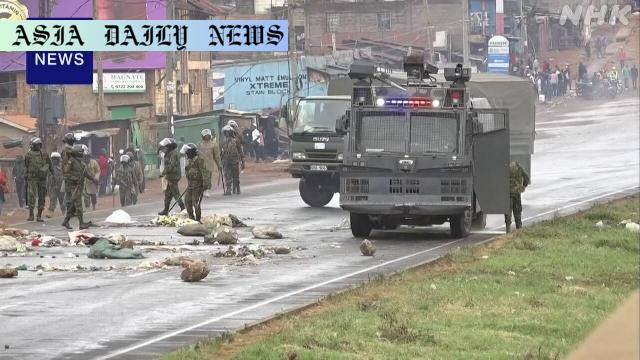Protesters in Kenya have taken to the streets, demanding that President William Ruto should step down.
Protests erupt across Kenya demanding President Ruto’s resignation.
Nationwide clashes result in at least 11 deaths and 567 arrests.
Human rights groups criticize police for violent crackdowns.

Background of the Protests
Kenya has long been regarded as a pillar of East Africa’s economy. However, a combination of factors, including the COVID-19 pandemic and severe droughts, has placed immense pressure on the country’s economic landscape. Citizens, particularly the youth, are grappling with skyrocketing prices of essential goods and rising unemployment rates. These issues have culminated in nationwide protests against President William Ruto, with demonstrators demanding his resignation.
On Monday, protesters took to the streets in various parts of the country. In many cases, these demonstrations escalated into violent confrontations with law enforcement. Security forces responded using tear gas, batons, and, according to some reports, live ammunition. As tensions flared, footage emerged showing protestors being beaten and forcefully subdued by police in the capital, Nairobi. Several human rights organizations have accused Kenyan police of excessive use of force during these operations.
The Human Cost of Political Unrest
The protests on Monday resulted in the deaths of at least 11 individuals, according to Kenyan police, with 567 arrests reported nationwide. These figures follow a similar trend seen during nationwide anti-government protests on June 25, where at least 16 lives were lost. Critics have called for investigations into these deaths, raising concerns over the conduct of the security forces. Many claim that violent crackdowns, including the alleged use of live bullets, have contributed to unnecessary casualties.
For citizens, the unrest is not just about politics but about survival and dignity. With rising tensions, ordinary Kenyans must contend with a volatile situation that jeopardizes not only their freedoms but also their safety.
Economic Struggles Fueling Unrest
Kenya’s economic challenges have played a catalytic role in sparking these nationwide protests. The aftereffects of the pandemic have plunged the nation into economic hardship, deteriorating further with record-breaking inflation and a prolonged drought. Coupled with the lack of sufficient government intervention and opportunities for a growing younger population, frustrations have reached a tipping point. Many demonstrators argue that President Ruto’s policies have failed to alleviate the financial burdens faced by ordinary citizens, compounding their hardships rather than ameliorating them.
Nevertheless, as Kenya’s economy struggles to regain stability, the social fabric of the nation risks being torn apart by these ongoing protests. The country’s leadership faces a critical challenge to address the growing inequalities that have left large sections of the population feeling abandoned and disenfranchised.
Criticism of State Response
While the protests initially centered around economic inequality and political dissatisfaction, much of the focus has now shifted to the Kenyan government’s response to these demonstrations. Images and videos of police violently dispersing crowds and reports of fatalities have sparked condemnation from human rights groups both within the country and internationally. Activists accuse the government of suppressing dissent rather than engaging in dialogue to address the root causes of unrest.
The role of law enforcement has come under intense scrutiny, with allegations of torture, arbitrary arrests, and disproportionate force. The ongoing tension between protesters and police highlights the fragile balance between maintaining order and upholding citizens’ rights.
The Path Forward
The unrest in Kenya underscores a broader issue of governance and economic management in a developing economy. The protests serve as a sobering reminder that economic growth figures mean little if the benefits are not widely shared among the population. While Kenya’s government has made efforts to address some economic challenges, meaningful solutions remain elusive.
Moving forward, dialogues between the government, civil society, and opposition forces are critical in finding a peaceful resolution to the issues at hand. Without significant reforms in governance, policing, and economic policy, Kenya risks further violence and instability in the near future.



Commentary
The Complexities of Protest in Modern Kenya
Kenya’s ongoing unrest raises profound questions about the interrelationship between governance, economic policy, and societal resilience. At its core, the movement by protesters is not solely about rejecting the leadership of President Ruto but about an underlying plea for dignity, opportunity, and fairness. In a nation as economically promising as Kenya, the persistence of such challenges speaks volumes about the difficulties of ensuring equitable growth.
The Failure of Leadership
The Ruto administration finds itself in challenging terrain. The increasing public dissent, fueled by economic despair, highlights a failure of leadership to manage crises proactively. Citizens are deeply frustrated by promises of prosperity that never materialized while facing soaring costs of living and dwindling job prospects. This discontent is particularly evident among Kenya’s youth, a demographic group that represents both hope and frustration in the nation’s future.
Navigating Political Turmoil
The government’s heavy-handed response to protests reveals a wider issue of how dissent is managed in fragile political climates. Using live ammunition and excessive force against its citizens does not portray strength but rather signals insecurity within the state. Leaders must learn that civil disobedience cannot be quelled by brute force; it requires addressing systemic issues through dialogue, reform, and empathy.
As the world watches Kenya, it becomes vital for the international community to support peaceful outcomes and assist in economic recovery. For Kenya’s people, the fight for their rights and livelihoods continues, channeled through resilience and hope for change.